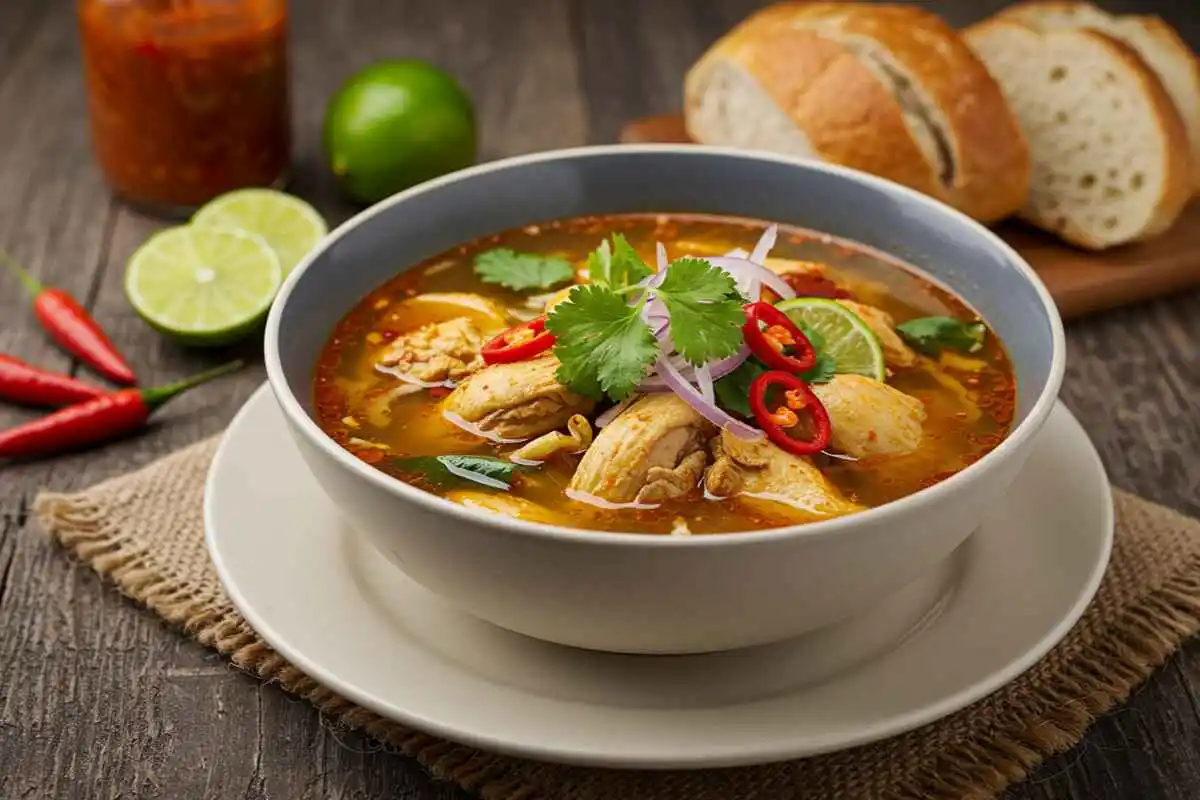1. Introduction
1.1 The Universal Appeal of Chicken Soup
Chicken soup has been a staple in many cultures for centuries, known for its comforting, nourishing, and healing properties. It is often the go-to dish when someone is feeling under the weather, offering warmth and sustenance. But beyond its medicinal reputation, chicken soup is also incredibly versatile and customizable.
- In Western cuisine, chicken soup is often a clear broth with vegetables, herbs, and sometimes noodles or rice.
- In Asian cultures, it might include ingredients like ginger, garlic, soy sauce, and lemongrass for added depth.
- In Latin America, it often features spicy peppers, tomatoes, and lime juice for a bold, tangy kick.
The adaptability of chicken soup allows for endless variations, and one of the most exciting ways to elevate it is by adding spices and heat. This not only enhances the flavor but also provides additional health benefits.
1.2 The Allure of Spicy Flavors
Spicy foods have been enjoyed for thousands of years, offering a unique sensory experience that excites the palate. The heat from chili peppers and other spices stimulates endorphin production, creating a natural feeling of pleasure and satisfaction.
Beyond taste, spicy ingredients offer numerous health benefits, such as:
- Boosting metabolism – Spicy foods can help increase calorie burn.
- Clearing congestion – Chili peppers and hot broths help relieve nasal congestion.
- Improving digestion – Ingredients like ginger and black pepper support gut health.
- Enhancing immunity – Many spices have antibacterial and antiviral properties.
When combined with chicken soup, the result is a dish that is not only comforting but also invigorating, making it a favorite in many cultures.
2. Historical Background of Spicy Chicken Soups
2.1 Origins of Spicy Cuisine
The use of spices in cooking dates back thousands of years. Early civilizations, such as those in India, China, and the Americas, discovered that certain spices could enhance the flavor of food, preserve ingredients, and provide medicinal benefits.
- Chili peppers were first cultivated in Central and South America around 7000 BC. They were later spread to the rest of the world through trade routes.
- Black pepper, turmeric, and ginger were staples in Indian and Chinese medicine, valued for their warming effects and healing properties.
- In Middle Eastern and African cuisines, spices like cumin, coriander, and cinnamon were used to create rich, complex flavors.
As global trade expanded, these spices traveled across continents, influencing how people cooked and flavored their meals.
2.2 Evolution of Chicken Soup Across Cultures
Chicken soup has existed for centuries, with each culture adding its unique twist. While the basic idea of simmering chicken in broth remains consistent, the choice of spices and additional ingredients varies.
- In China, chicken soup is often infused with ginger, scallions, and medicinal herbs, believed to promote health and longevity.
- In Mexico, the traditional Caldo de Pollo includes chili peppers, lime, and cilantro, creating a spicy and tangy profile.
- In Korea, Dakgaejang is a fiery chicken soup made with gochugaru (Korean chili flakes) and sesame oil, giving it a distinctive red color and deep heat.
- In Nigeria, Pepper Soup is a bold, spicy dish featuring Scotch bonnet peppers, garlic, and native spices.
Over time, these different styles of spicy chicken soup have influenced one another, resulting in fusion recipes and innovative variations that continue to evolve today.
3. Global Varieties of Spicy Chicken Soups
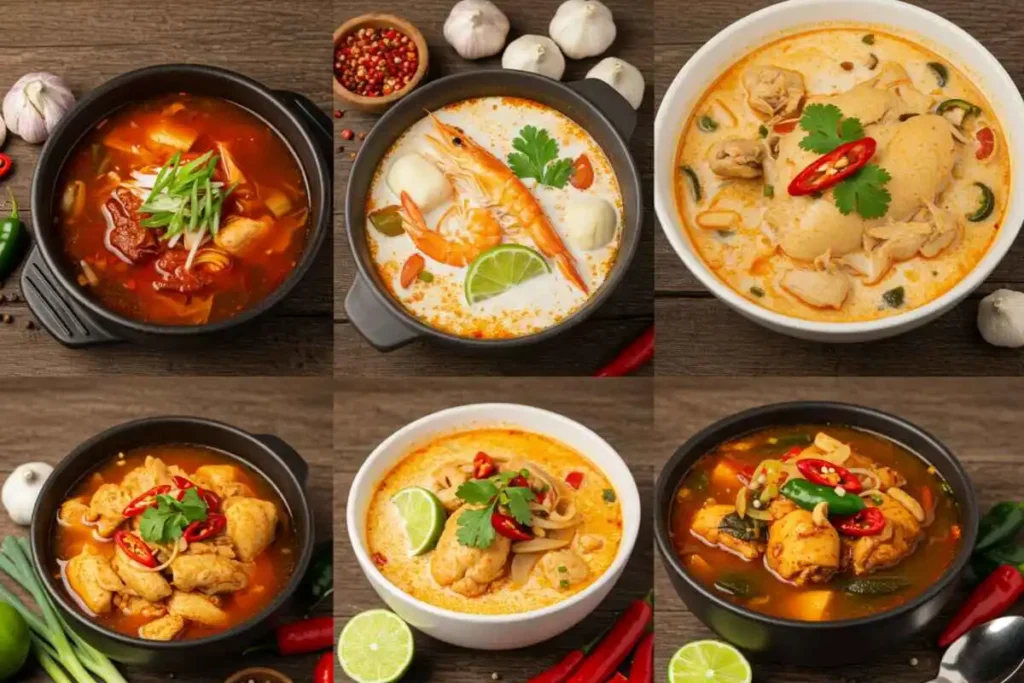
3.1 Southeast Asian Variants
3.1.1 Tom Kha Kai (Thailand)
Tom Kha Kai is a Thai coconut chicken soup that balances spicy, tangy, and creamy flavors. It is made with:
- Chicken (usually breast or thigh)
- Coconut milk for richness
- Lemongrass, galangal, and kaffir lime leaves for freshness
- Thai bird’s eye chilies for heat
- Fish sauce and lime juice for umami and acidity
This soup is warming yet refreshing, making it a favorite for those who enjoy spice without overwhelming heat.
3.1.2 Soto Ayam (Indonesia)
Soto Ayam is an Indonesian-style spicy chicken soup with a vibrant yellow broth, flavored with:
- Turmeric and ginger for color and warmth
- Garlic and shallots for depth
- Chili peppers for heat
- Hard-boiled eggs and rice noodles for texture
It is often served with krupuk (crispy crackers) and fresh lime for added flavor.
3.2 East Asian Variants
3.2.1 Spicy Korean Chicken Soup (Dakgaejang)
Dakgaejang is a fiery Korean soup known for its bold red color and intense spice. Key ingredients include:
- Shredded chicken (usually from a whole boiled chicken)
- Gochugaru (Korean chili flakes) for spiciness
- Soybean sprouts for crunch
- Garlic, scallions, and sesame oil for umami
This soup is a popular dish in Korean cuisine, especially in colder months.
3.2.2 Chinese Mala Chicken Soup
Mala chicken soup is a Sichuan-style dish featuring the famous “numbing and spicy” (mala) sensation. Ingredients include:
- Sichuan peppercorns for a tingling effect
- Dried red chilies for fiery heat
- Chicken, tofu, and mushrooms for substance
- Soy sauce and rice wine for depth
The combination of spice and numbing heat makes this soup a must-try for lovers of bold flavors.
3.3 South Asian Variants
3.3.1 Indian Pepper Chicken Soup
In India, pepper chicken soup is a warming and medicinal dish often consumed during monsoons. It features:
- Black pepper and ginger for spiciness
- Turmeric and curry leaves for aroma
- Garlic and cumin for depth
This soup is popular for relieving colds and boosting immunity.
3.3.2 Sri Lankan Kottu Roti Soup
A Sri Lankan twist on chicken soup, this dish includes:
- Shredded flatbread (Kottu Roti) for texture
- Coconut milk for creaminess
- Chili peppers and curry powder for bold heat
It is both spicy and filling, making it a comforting meal.
4. Key Ingredients and Their Roles
4.1 Proteins: Chicken Cuts and Their Uses
The type of chicken used in spicy chicken soup plays a significant role in its flavor and texture. Choosing the right cut can enhance the broth, provide depth, and create a rich, well-balanced soup.
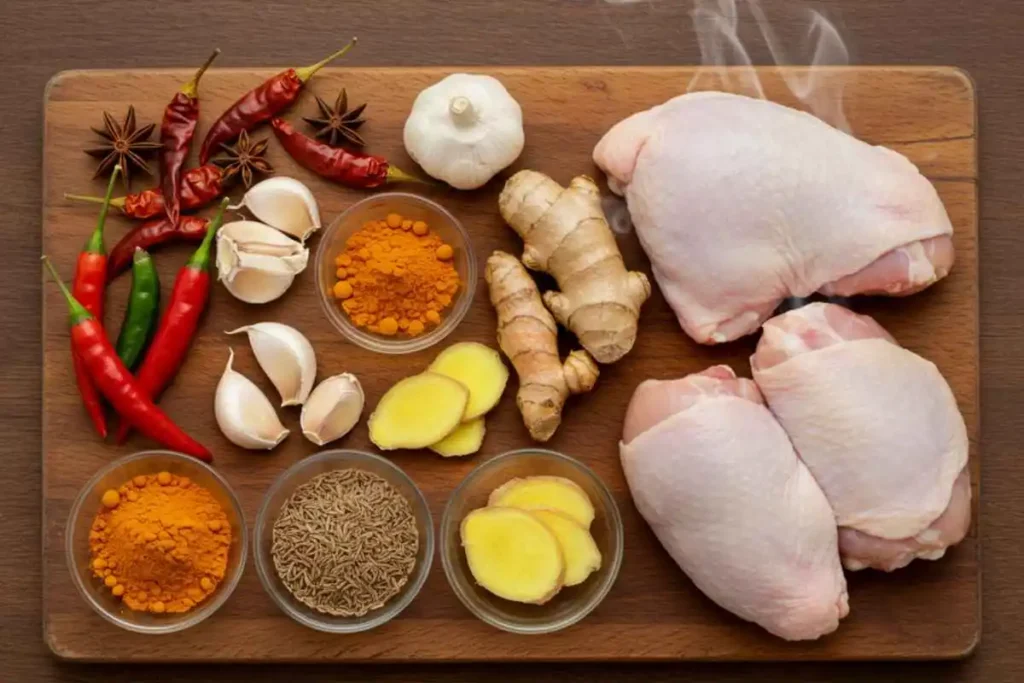
Bone-in vs. Boneless Chicken
- Bone-in chicken (thighs, drumsticks, or whole chicken) releases natural collagen and fat, creating a richer, deeper broth.
- Boneless chicken (breast or thigh fillets) is leaner and more convenient, but it requires additional ingredients like butter or oil to enrich the soup.
Shredded vs. Chunked Chicken
- Shredded chicken (common in Korean and Mexican soups) soaks up the broth’s spices, offering a tender texture.
- Chunked chicken pieces retain more bite, making the soup more filling.
For vegetarian adaptations, tofu, mushrooms, or jackfruit can replace chicken while still absorbing the bold spicy flavors.
4.2 Spices and Herbs: The Heart of Heat
The spice blend determines the level of heat and depth of flavor in spicy chicken soups.
Essential Spices for Heat
- Chili peppers (fresh, dried, or powdered) – The primary source of spice, ranging from mild jalapeños to fiery Scotch bonnets.
- Black pepper – Adds a warm, subtle heat that enhances other flavors.
- Ginger and garlic – Provide a pungent kick that complements the soup’s warmth.
- Turmeric – Used in Indian and Southeast Asian soups for its anti-inflammatory properties and bright color.
Flavor-Enhancing Herbs
- Lemongrass – Common in Thai soups for a citrusy, fresh contrast to spice.
- Cilantro and parsley – Used as a garnish to balance bold flavors.
- Curry leaves – Found in South Asian soups, adding an earthy aroma.
4.3 Broth Bases: Building Flavor Foundations
A good broth is the backbone of any chicken soup, providing richness and depth.
Types of Broths Used in Spicy Chicken Soups
- Chicken stock (homemade or store-bought) – The most common base, rich in nutrients and flavor.
- Coconut milk – Adds creaminess and tempers extreme spiciness (used in Thai and Sri Lankan soups).
- Tomato-based broth – Common in Mexican and Nigerian soups, adding acidity and body.
4.4 Vegetables and Add-ins: Enhancing Texture and Nutrition
Adding vegetables not only enhances nutrition but also improves texture and complexity.
Best Vegetables for Spicy Chicken Soup
- Onions and garlic – A flavor foundation in almost every variation.
- Carrots and potatoes – Provide natural sweetness to balance heat.
- Bell peppers – Offer a smoky, slightly sweet contrast to chili peppers.
- Leafy greens (spinach, bok choy, kale) – Boost nutrition and color.
These ingredients make the soup more well-rounded, nutritious, and visually appealing.
5. Health Benefits of Spicy Chicken Soups
5.1 Nutritional Profile of Common Ingredients
A bowl of spicy chicken soup is more than just comfort food—it’s packed with essential nutrients.
Macronutrients in Spicy Chicken Soup
- Protein – From chicken, crucial for muscle repair and immune function.
- Healthy fats – From chicken skin, coconut milk, or oil, providing long-lasting energy.
- Complex carbohydrates – From vegetables and noodles, offering sustained fuel.
Key Micronutrients
- Vitamin C – Found in peppers and lime juice, boosting the immune system.
- Iron & zinc – From chicken and bone broth, supporting red blood cell production.
- Capsaicin – The compound in chili peppers that promotes fat burning and circulation.
5.2 Therapeutic Effects of Spices
Spicy soups are often used as home remedies for colds, digestion, and overall wellness.
How Spices Aid Health
- Capsaicin (in chilies) – Acts as a decongestant and pain reliever.
- Ginger – Soothes an upset stomach and reduces inflammation.
- Turmeric – Contains curcumin, a powerful anti-inflammatory agent.
- Garlic – Boosts the immune system and has antibacterial properties.
Regularly consuming spicy chicken soups can help digestion, improve circulation, and strengthen immunity.
6. Cooking Techniques and Tips
6.1 Traditional Methods
Many cultures use time-tested techniques to extract maximum flavor from their soups.
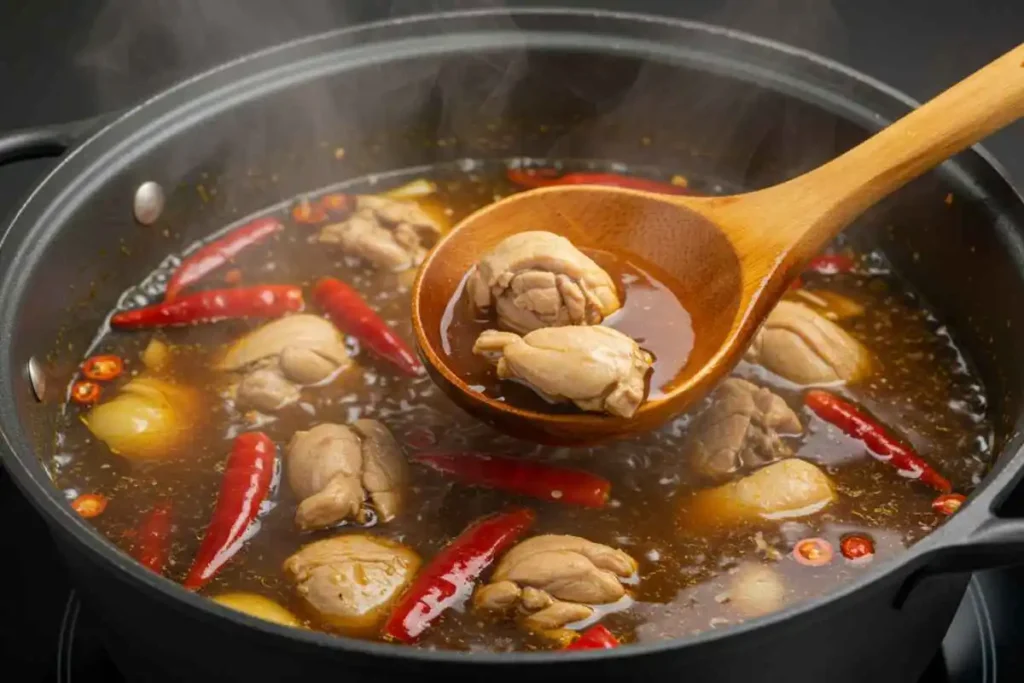
Slow Simmering (Stockpot Method)
- Used in classic homemade chicken soup recipes.
- Involves cooking broth for hours to extract deep flavors.
- Best when using bone-in chicken to get a rich, collagen-filled broth.
Hand-Grinding Spices
- Toasting and grinding whole spices intensifies their aroma and flavor.
- Used in Indian, Middle Eastern, and African cooking.
6.2 Modern Adaptations
If you’re short on time, modern cooking methods can still yield delicious spicy chicken soups.
Instant Pot / Pressure Cooker
- Reduces cooking time from hours to minutes while preserving flavors.
- Locks in moisture, making chicken extra tender.
Blended Soups for Smooth Texture
- Some variations, like Thai Tom Kha Kai, are blended for a creamy consistency.
- Works well with coconut milk-based soups.
Both traditional and modern techniques can produce a rich, satisfying bowl of spicy chicken soup.
7. Popular Recipes
7.1 Classic Spicy Chicken Noodle Soup
A simple yet flavorful twist on traditional chicken noodle soup.
Ingredients:
- 2 chicken breasts, shredded
- 6 cups chicken broth
- 2 cloves garlic, minced
- 1 teaspoon red pepper flakes
- 1 jalapeño, sliced
- 1 cup egg noodles
- Salt & pepper to taste
Instructions:
- Sauté garlic and jalapeños until fragrant.
- Add broth and chicken, bring to a boil.
- Stir in noodles, cook until tender.
- Season with salt, pepper, and red pepper flakes.
7.2 Spicy Mexican Chicken Soup
A hearty Caldo de Pollo with smoky chipotle heat.
Key Ingredients:
- Bone-in chicken thighs
- Tomatoes, onions, garlic
- Chipotle peppers in adobo sauce
- Fresh lime juice and cilantro
7.3 Thai Spicy Coconut Chicken Soup
A creamy yet fiery Tom Kha Kai recipe.
Key Ingredients:
- Chicken thighs, coconut milk
- Lemongrass, kaffir lime leaves
- Thai bird’s eye chilies
- Fish sauce, lime juice
7.4 Nigerian Pepper Chicken Soup
One of the spiciest chicken soups in the world, packed with Scotch bonnet peppers.
Key Ingredients:
- Whole chicken, cut into pieces
- Scotch bonnet peppers
- Nigerian spice blend (Ehuru, Uziza, and Uda)
- Onions, garlic, ginger
8. Frequently Asked Questions (FAQs)
8.1 How do I spice up my chicken soup?
If you want to add more spice to your chicken soup, try these methods:
- Add fresh or dried chili peppers (such as jalapeños, habaneros, or bird’s eye chilies).
- Incorporate chili powder, cayenne pepper, or red pepper flakes for a balanced heat.
- Use spicy condiments like Sriracha, gochujang, or harissa for an extra kick.
- Enhance flavors with black pepper and ginger to complement the spice.
8.2 What can I add to soup to make it spicy?
Here are some ingredients that can elevate the heat of your soup:
- Hot sauces (Tabasco, chili oil, or sambal oelek).
- Spicy broths (made with Sichuan peppercorns or chipotle chilies).
- Infused oils (chili-infused olive oil or sesame oil for extra depth).
8.3 How to make spicy chicken soup?
To make a basic spicy chicken soup, follow these steps:
- Sauté garlic, onions, and chili peppers for a flavorful base.
- Add chicken and broth, simmer until the chicken is tender.
- Incorporate seasonings like cayenne, paprika, or curry powder.
- Finish with fresh herbs, lime juice, or coconut milk for balance.
8.4 How to jazz up chicken soup?
If your chicken soup feels bland, try these tricks:
- Add acidity (a splash of lime juice, vinegar, or tomatoes).
- Use fresh herbs like cilantro, basil, or parsley for brightness.
- Mix in umami boosters like fish sauce, miso paste, or soy sauce.
- Top with crunchy garnishes (crispy shallots, toasted sesame seeds, or crushed peanuts).
Conclusion
9.1 The Enduring Comfort of Spicy Chicken Soups
Spicy chicken soups are more than just a meal—they’re an experience of bold flavors, warmth, and nourishment. Whether you’re craving a fiery Korean Dakgaejang, a creamy Thai Tom Kha Kai, or a rich Nigerian Pepper Soup, there’s a version for everyone.
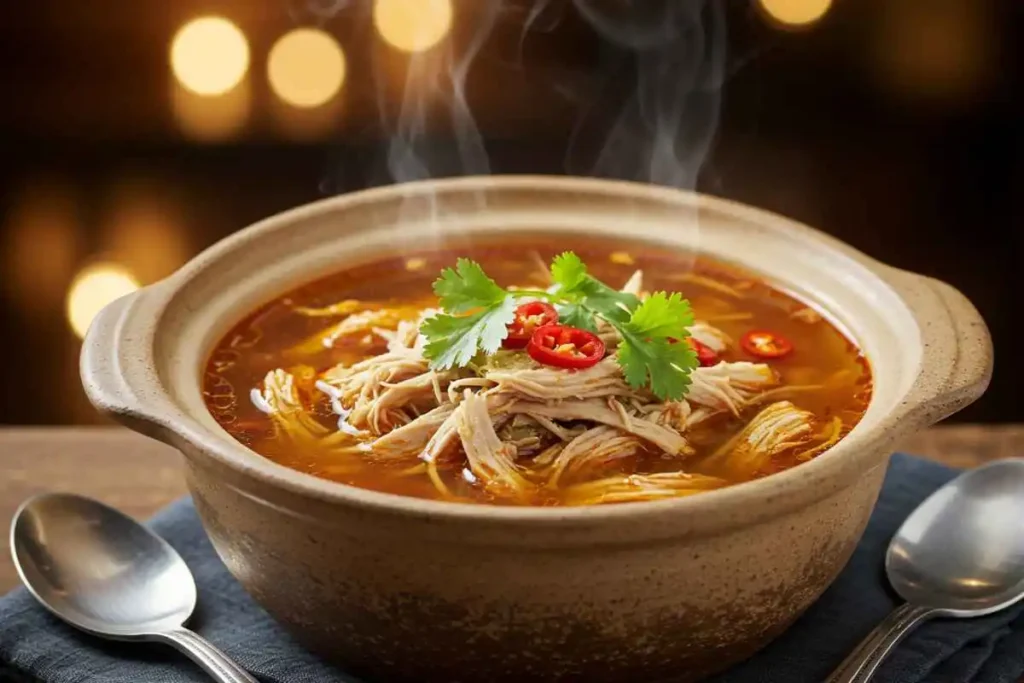
Beyond taste, these soups offer numerous health benefits, from boosting immunity to improving digestion. The combination of spices, protein, and vegetables makes them a nutrient-dense, satisfying choice for any occasion.
9.2 Encouragement to Explore and Experiment
The best part about making spicy chicken soup is the freedom to experiment. Adjust the level of heat, swap ingredients to match your preference, and explore different cultural variations to find your perfect bowl.
Next time you want something warming, flavorful, and healthy, try a spicy chicken soup—it might just become your new favorite dish!

